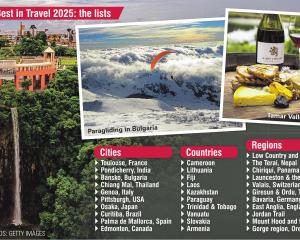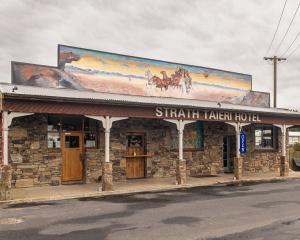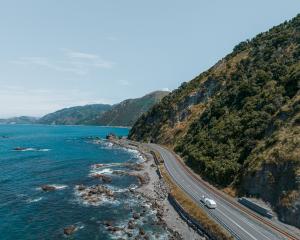While West Coast coal mining might be suffering, tourism is flourishing. Philip Somerville samples several of the Coast's visitor attractions.
It's a common traveller's cry: ''I wish we had more time to ...''
Twice on our short sojourn to the West Coast this thought really struck home.
The first time was when we had to make do with a pleasant bush railway ride and climb to a cave entrance.
Give us four hours and we would have gone caving, floating underground on inner tubes by the light of glow-worms and then whisking down the Nile River.
On the second occasion we couldn't quite squeeze in the longish drive and short walk to Hokitika Gorge.
It was on our schedule and Russell King, of the Coleraine Motel, where we were staying in Greymouth, proposed it take priority over other stops: never mind.
My wife Shona and I arrived on the Coast via the TranzAlpine train from Christchurch about 1pm.
While the largest numbers of visitors turn left towards the glaciers and the likes of white heron or kiwi tours we headed north, by rental car.
Thankfully, on our first afternoon, we had time to soon pause, and then pause again and again.
The so-called ''Great Coast Road'' is spectacular just north of Greymouth with its offshore rock stacks, beaches and forest-clad slopes backed by the jagged Paparoa mountains.
It's easy to see why the West Coast has made the Lonely Planet guide's top 10 coastal drives.
We stopped at the impressive Punakaiki Pancake Rocks and Blowholes for a wander and a gawk, and then we pushed on to Cape Foulwind for agreeable scenery, a lighthouse and a grandstand view of a thriving seal colony.
Missing on the east coast is the shimmering pleasure of revelling in the sun setting over the sea. With sunny spring skies, we sat on the sand and saw the day draw in.
Sometimes when travelling, small serendipitous encounters add to the enjoyment.
Because the suggested cafe and restaurant was closed, we called, a little cautiously, at the local country pub, the Star Tavern, Cape Foulwind, to see what it might offer. While I'm somewhat sceptical about stereotypes, I was immediately met by ''Coaster'' hospitality.
Derek interrupted his table tennis game for a hearty welcome to a stranger.
From the warmth of the homely tavern we adjourned to a luxury cottage at Birds Ferry Lodge, a private hideaway set in 13ha.
The Coast is keen on ''high-end'' visitors as well as the rest of us, host Alison Gygax explains.
We meet her after traversing the property's bush walk the next morning.
Most guests through the busier summer were from overseas, while New Zealanders tended to visit during the winter when the tariffs were lower.
Nearby at Charleston, south of Westport, once a booming gold-mining community, is the rapidly growing ''Underworld Adventures''.
Co-founder Geoff Schurr tells of the early days in the late 1980s.
The first year they had but four customers and the business was about to go under.
Just in time, backpacker bus groups cottoned on, and it's been steadily growing about 4% a year since.
Mr Schurr, originally from Balclutha, co-founder Ray Moroney and the crew now host about 4000 people a year on ''underworld rafting'' (cost $175 a person) through the caves and down the river.
This attraction already has strong bookings through the summer.
There's also a much easier glow-worm cave tour, a tough ''adventure'' caving option and the easiest, the ''Nile River Rainforest Train'', the activity we sampled.
It chugs though a valley where the BBC filmed The Lost World in the early 2000s.
All up, visitor numbers now top 10,000, and the success is reflected in a large new headquarters building.
It was poignant to move from hearing about underground fun to seeing the tough life of underground miners illustrated at another near-new and smart facility, the Coaltown Museum at Westport.
It was poignant, too, to contrast a thriving tourist business with the current woes of the West Coast mining industry.
We found the stories of life on the Denniston Plateau and the famous Denniston Incline of interest, and spent nearly an hour looking around.
The plateau itself and its visitor centre are well worth a visit.
We'd been there before, and there was insufficient time for a return visit. So it's inland to Reefton and black billy tea with town characters the Bearded Miners.
As we do in several places, we make time for Shona to visit shops and studios. She enjoyed a long and inspiring chat with local artist Alison Hale in her main street gallery.
Back in Greymouth we have to fit in a tour of Monteith's brewery, and on our last morning we head south towards the West Coast Treetop Walk, near Hokitika.
It's modelled on similar structures and experiences in Australia, with easy access along steel platforms 20m high and among the rimu and kamahi.
It's 450m long and includes a cantilevered section.
You also climb the Hokitika Tower, 47m above the forest floor, the extra elevation almost a little too ''exhilarating'' for those like Shona who usually don't do heights.
The walk, with views to the Southern Alps and over Lake Mahinapua, has been open three years and cost $7.5million to construct.
It is looking at a boost as the West Coast Wilderness Trail, a new cycleway from Greymouth, is extended south of Hokitika to Ross.
On the way to the Treetop walk, and on a whim, we detoured a few hundred metres off the main road to the Department of Conservation camping ground at the lake.
What a beauty it is with bush, lake and mountain backdrop.
We're in Hokitika on a Sunday morning and the smart Mountain Jade business, where we are shown around, is already busy even though the main tourist season is just beginning.
Hokitika markets itself as the jade capital, and there are several shops and studios selling carved New Zealand greenstone (pounamu) as well as jade from other parts of the world.
There are plenty of Asian visitors already out and about, a reflection of where the fastest tourist growth is coming from.
Tourist numbers on the Coast climbed 12% over the 12 months to the end of March, much faster than the rest of New Zealand.
Chinese numbers are up a massive 220%, at almost 30,000, while Australians number more than 100,000. More than half a million visitors come from overseas.
Domestic tourism is also increasing, even it it is not quite so strong, and tourism is said to be worth $309million to the Coast and be behind 2731 full-time-equivalent jobs.
Finding accommodation has become difficult in February and March, encouraging the tourism industry to focus on shoulder seasons.
It's time to return to the bustle and busyness of Greymouth Railway Station as the TranzAlpine is readied for its return to Christchurch.
The visit might, indeed, have been too short, but there is always another time.
Those caves and that gorge await.
• Philip Somerville is Otago Daily Times editorial manager. His trip was supported by Tourism West Coast.












